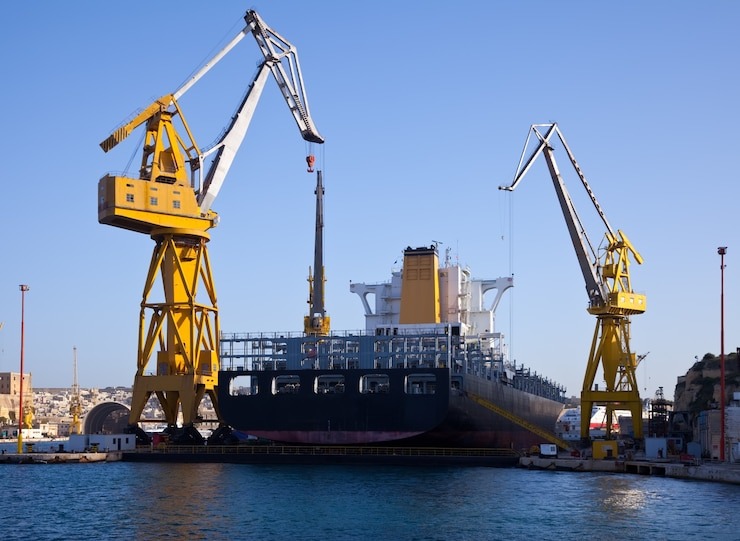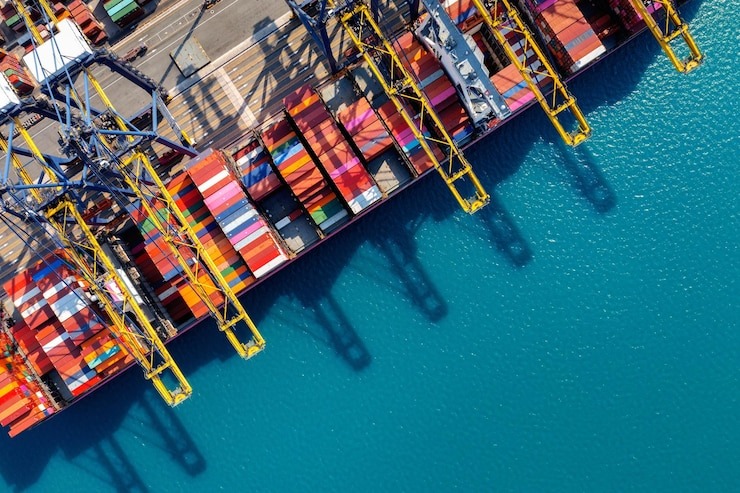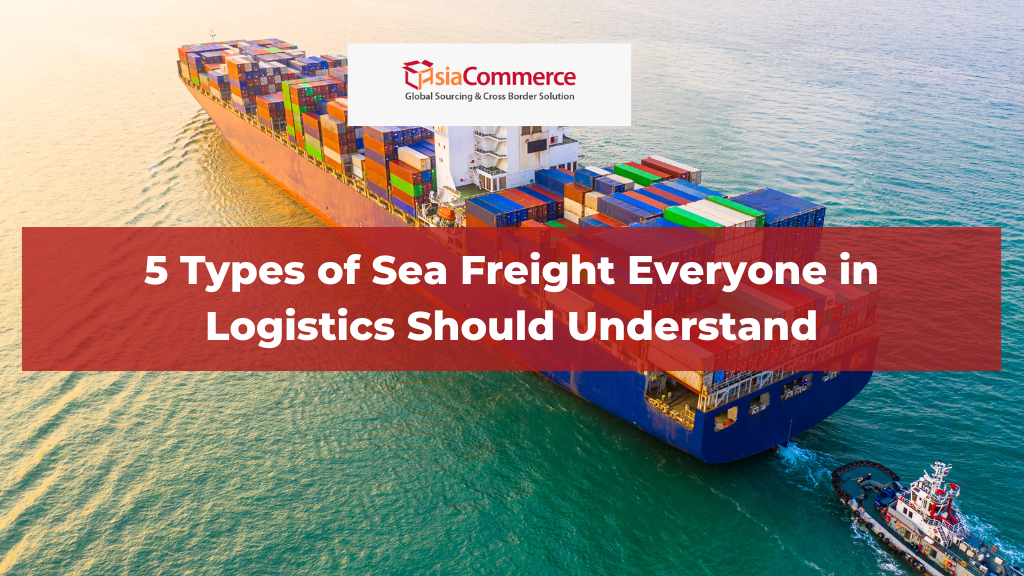In today’s interconnected global landscape, shipping goods across oceans has become one of the fundamental pillars of the global supply chain. Behind its convenience and complexity lies a method every international business owner should know: sea freight .
Understanding this mode of transportation is crucial for grasping the ins and outs of shipping goods by sea. In this article, we’ll dive deep into what sea freight truly means, its pivotal role in global logistics, and why having a solid understanding of this concept is essential for both businesses and consumers. By exploring its intricacies, you’ll gain valuable insights that can elevate your approach to international trade and shipping.
What is Sea Freight?

You’ve probably heard the term “sea freight” before, but what exactly does it mean? Sea freight is one of the primary methods for shipping goods around the world, and it involves transporting cargo via container ships. In the logistics world, this method is also commonly referred to as Ocean Freight or Container Shipping . So, how does it work? Your goods are packed into containers, which are then loaded onto ships and sent to your desired destination.
This, in essence, is what we know as sea freight. And there’s a good reason why this shipping method has become the go-to choice for international trade. Not only is it efficient, but it’s also incredibly versatile, capable of handling a wide variety of goods—from dry cargo and liquid bulk to oversized shipments.
With all its advantages, it’s no surprise that sea freight serves as the backbone of the global trading network, ensuring goods move smoothly across continents and oceans.
Also Read : The 7 Types of Air Freight You Need to Know for Smarter Shipping Decisions
Types of Sea Freight: Exploring the Best Options for Your Shipping Needs
When it comes to sea freight, not all shipments are created equal. Different types of cargo require different handling methods, and understanding these options is key to making informed decisions. Let’s dive into the five main types of sea freight and explore how each one works, why it’s used, and what makes it unique.
1. Full Container Load (FCL) – Exclusive container use for one shipment
If you’re shipping large quantities of goods, Full Container Load (FCL) is the way to go. This method involves filling an entire container exclusively with your cargo, ensuring that no other shipments are mixed in.
So, why is FCL so popular? First, it offers unparalleled security and control over your shipment. Since the container is dedicated solely to your goods, there’s less risk of damage or mix-ups during transit. Additionally, FCL simplifies logistics because you don’t have to worry about coordinating with other shippers. The process is straightforward: pack your container, seal it, and send it off.
For businesses with high-volume shipments, FCL not only ensures efficiency but also provides peace of mind. You’ll know exactly where your goods are at all times, and they’ll arrive at their destination in pristine condition.
2. Less than Container Load (LCL) – Shared container for smaller shipments
What if your shipment isn’t large enough to fill an entire container? No problem! That’s where Less than Container Load (LCL) comes in handy. With LCL, your goods are combined with shipments from other businesses to fill a single container. This shared approach is perfect for small- to medium-sized shipments, as it allows you to split the cost of container space with others.
Why choose LCL? It’s a cost-effective solution for businesses with limited cargo volume. Instead of paying for an entire container, you only pay for the space you use. Plus, LCL is flexible—it accommodates varying shipment sizes without compromising delivery timelines. While the process may involve slightly more coordination compared to FCL, the savings and convenience make it a smart choice for many importers and exporters.
3. Roll-on/Roll-off (RoRo) – Ideal for wheeled cargo like vehicles
Imagine shipping vehicles like cars, trucks, or heavy machinery overseas. How do you transport such bulky items efficiently? Enter Roll-on/Roll-off (RoRo) shipping.
As the name suggests, this method allows vehicles to “roll on” and “roll off” the ship using ramps. It’s as simple as driving your vehicle onto the ship at the port of origin and driving it off at the destination.
Why is RoRo so effective? First, it eliminates the need for complex loading and unloading processes. Vehicles are treated as standalone units, reducing the risk of damage during transit. RoRo is also highly scalable, making it ideal for businesses that need to transport multiple vehicles at once. Whether you’re shipping a single car or an entire fleet, RoRo ensures safe, efficient, and hassle-free transportation.
4. Break Bulk Shipping – For oversized or non-containerizable cargo
Not everything fits neatly into a container. For oversized or irregularly shaped items—like construction equipment, wind turbines, or industrial machinery—Break Bulk Shipping is the answer.
In this method, goods are loaded individually onto the ship rather than being packed into containers. These items often require specialized handling, such as cranes or rigging, to ensure safe loading and unloading at the port.
Why is Break Bulk Shipping essential? It’s the only practical solution for transporting goods that are too large, heavy, or awkward to fit into standard containers. While this method may take longer and require more planning, it’s indispensable for industries that rely on heavy machinery or large-scale infrastructure projects. With proper coordination, Break Bulk Shipping ensures that even the most challenging cargo reaches its destination safely.
5. Liquid Bulk Shipping – Designed for liquids such as oil, chemicals, and gases
Finally, let’s talk about liquids. Shipping large quantities of oil, gas, chemicals, or other liquid products requires a specialized solution: Liquid Bulk Shipping .
This method uses tanker ships designed specifically to transport liquid cargo. These vessels are equipped with advanced safety features to prevent leaks and spills, ensuring that hazardous or valuable liquids are transported securely.
Why is Liquid Bulk Shipping critical? It plays a vital role in global trade, supporting industries like energy, agriculture, and manufacturing. Without tanker ships, it would be nearly impossible to move bulk liquids across oceans efficiently. Whether you’re shipping edible oils, petroleum, or industrial chemicals, Liquid Bulk Shipping offers a reliable and scalable solution for your needs.
The Sea Freight Delivery Process

1. Packaging the Goods
The first step in your sea freight adventure is ensuring your goods are securely packaged. Proper packaging isn’t just about aesthetics—it’s essential for protecting your items from shocks, vibrations, and harsh weather conditions during the long ocean voyage. Whether it’s sturdy crates, waterproof wrapping, or specialized containers, taking the time to package your goods correctly ensures they arrive in perfect condition.
2. Transporting Goods to the Port
Once your goods are safely packaged, they’re ready to be transported to the loading port. This is where the action begins: documents are checked, formalities are completed, and all necessary preparations are made to ensure your shipment is loaded onto the ship smoothly. This step is crucial because any delays here could affect the entire shipping schedule.
3. Loading Goods onto the Ship
Upon arrival at the port, it’s time for your goods to board the ship. They’ll be carefully loaded into the vessel, either as part of a Full Container Load (FCL) or combined with other shipments in a Less than Container Load (LCL). The method depends on the size and nature of your shipment. Regardless of the type, precision and care are key to ensuring everything is securely stowed for the journey ahead.
4. Ocean Voyage
Now, your goods set sail! The duration of the voyage depends on the route and distance between the origin and destination ports. During this time, modern tracking systems allow you to monitor your shipment’s progress in real-time. While the sea can be unpredictable, rest assured that experienced crews and advanced technology work together to ensure a safe and timely journey.
5. Arrival at the Destination Port
When your goods arrive at the destination port, they’re greeted by customs officials who inspect the accompanying documentation. Once cleared, they’re ready to disembark and continue their journey. This step ensures compliance with local regulations and prepares your shipment for the final leg of its trip.
6. Final Distribution and Delivery
Finally, your goods are picked up and delivered to their ultimate destination. Whether by truck, train, or courier, they’re transported to the hands of their rightful recipients. After a long journey across the seas, your goods are now ready to begin the next chapter of their story—whether that’s reaching customers, stocking shelves, or fueling business growth.
Also Read : 5 Tips for Easily Finding Cheap Chinese Suppliers 2025
Key Factors Affecting Sea Freight Costs
1. Distance and Shipping Route
The distance your shipment needs to travel and the chosen route significantly impact the overall cost. Think of it as an oceanic adventure—your goods are embarking on a journey across vast waters. The farther the destination and the more complex the route, the higher the challenges and costs. For instance, navigating through busy ports or taking longer routes due to weather conditions can increase expenses. So, always consider the logistics of the journey when estimating costs.
2. Type and Volume of Goods
Are your goods lightweight or heavy? Do they require special handling? The size, weight, and nature of your cargo directly affect shipping costs. Bulky items or those needing extra care—like fragile or perishable goods—require more space and attention, which translates to higher fees. On the other hand, smaller, standardized shipments may be more affordable. Understanding your cargo’s characteristics helps you anticipate potential costs and make informed decisions.
3. Type of Container
Will you opt for a full container or share space with others? Your choice here will influence the cost. A Full Container Load (FCL) offers exclusivity, giving you the entire container to yourself, which is ideal for large shipments. However, if your cargo doesn’t fill an entire container, sharing space through Less than Container Load (LCL) can be a more economical option. While LCL saves money, it may involve slightly more coordination. Choose wisely based on your shipment size and budget.
4. Frequency of Shipments
How often do you ship goods? If you’re a frequent shipper with high volumes, shipping companies might offer you more competitive rates. Building a consistent relationship with carriers can lead to discounts or favorable terms. On the flip side, occasional or one-off shipments might come with higher costs. Regular shipping not only streamlines your logistics but can also save you money in the long run.
5. Season and Weather Conditions
Seasonal fluctuations and weather conditions also play a role in determining costs. Extreme seasons, such as peak shipping periods around holidays, often lead to higher demand and, consequently, increased prices. Similarly, adverse weather like storms or rough seas can cause delays or even rerouting, which might result in additional charges. Always keep an eye on seasonal trends and plan accordingly to avoid unexpected costs.
6. Additional Services
Do you want extra peace of mind? Adding services like insurance, special handling, or door-to-door delivery will increase the overall cost—but they can also provide added security and convenience. For example, insuring your goods protects against potential losses, while specialized handling ensures delicate items arrive safely. While these services come at a premium, they’re often worth the investment for valuable or sensitive shipments.
7. Regulations and Taxes
Lastly, don’t forget about import and export regulations and taxes. These can vary significantly depending on the countries involved and the type of goods being shipped. Customs duties, port fees, and compliance with international trade laws can all add to the total cost. Failing to account for these factors might leave you with unexpected expenses. To avoid surprises, ensure you research and include these costs in your planning.
Differences Between Sea Freight and Air Freight
1. Mode of Transportation
- Sea Freight : Sea freight relies on cargo ships to transport goods across oceans. It’s a tried-and-true method that has been the backbone of global trade for centuries.
- Air Freight : Air freight, on the other hand, uses airplanes to move goods through the air. This mode is ideal for shipments that prioritize speed over cost.
The choice between these two modes depends on your priorities—whether you value affordability and capacity (sea freight) or speed and efficiency (air freight).
2. Speed of Delivery
- Sea Freight : Shipping via sea freight typically takes longer because cargo ships travel at slower speeds compared to airplanes. For example, a shipment from Asia to Europe might take weeks by sea.
- Air Freight : Air freight is significantly faster, as airplanes can cover vast distances in a matter of hours or days. If time is of the essence, air freight is the clear winner.
While sea freight may test your patience, it’s often the go-to option for non-urgent shipments. Air freight, however, is perfect for time-sensitive deliveries.
3. Shipping Costs
- Sea Freight : Sea freight is generally more affordable, especially for large or heavy shipments. The cost per unit is lower because ships can carry massive volumes of cargo in a single journey.
- Air Freight : Air freight tends to be more expensive due to higher operational costs, including fuel, airport fees, and handling charges. However, its speed often justifies the price for urgent or high-value shipments.
If budget is a primary concern, sea freight is the smarter choice. But if you’re willing to pay a premium for speed, air freight delivers unmatched efficiency.
4. Route Availability
- Sea Freight : Sea freight offers extensive route options, thanks to the vast network of ports worldwide. Ships can reach almost any coastal destination, making it a versatile choice for global trade.
- Air Freight : Air freight is limited to routes served by airlines, and not all locations have airports equipped to handle cargo. This limitation can make air freight less accessible for remote or landlocked regions.
For businesses targeting diverse markets, sea freight provides greater flexibility in terms of destinations. Air freight, while fast, is better suited for major urban centers with well-equipped airports.
5. Capacity and Types of Goods
- Sea Freight : Sea freight is ideal for large shipments or heavy cargo, such as machinery, vehicles, or bulk commodities. It’s also suitable for goods that aren’t time-sensitive, like raw materials or seasonal products.
- Air Freight : Air freight is typically used for smaller, lightweight shipments or high-value items like electronics, pharmaceuticals, or fashion goods. Its speed makes it perfect for urgent deliveries or perishable items.
Each mode caters to different types of cargo, so consider the nature of your goods when deciding between the two.
6. Environmental Impact
- Sea Freight : While sea freight is more cost-effective, it has a larger environmental footprint. Cargo ships burn fossil fuels and emit greenhouse gases, contributing to climate change. However, they are more fuel-efficient per ton of cargo compared to airplanes.
- Air Freight : Air freight also has a significant environmental impact, as airplanes consume aviation fuel, releasing CO2 and other pollutants into the atmosphere. While faster, this mode is less sustainable for large-scale shipments.
Businesses aiming for greener logistics should weigh the environmental implications of each mode. Sea freight might be the better long-term choice for eco-conscious companies, despite its slower pace.
Hassle-Free Imports Without Hidden Fees — Only at AsiaCommerce
Looking to import without dealing with the hassle of complex procedures? Look no further than AsiaCommerce ! We are committed to making your import process smoother, easier, and free from unnecessary hidden costs. With our comprehensive services, you can focus on growing your business while we handle all the details. From managing essential documents and customs clearance to providing transparent cost calculations, we ensure there are no surprises along the way. Our clear pricing structure eliminates worries about unexpected expenses, giving you peace of mind throughout the process.
In addition to seamless logistics, we offer Quality Control (QC) services to guarantee that your imported goods meet your expected standards. If any items don’t meet your requirements, returns are hassle-free. We also assist with handling payments in RMB, simplifying your international transactions. Whether you’re a small business or a large enterprise, AsiaCommerce provides practical and efficient import solutions tailored to your needs. Ready to experience stress-free importing? Click here or click the banner now to get started and discover a level of convenience you’ve never experienced before!


0 Comments